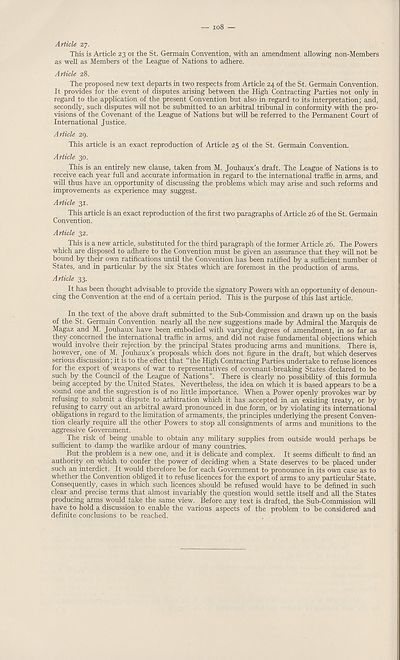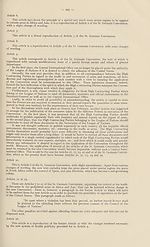Armament > Conference for the control of the international trade in arms, munitions and implements of war
(110)
Download files
Complete book:
Individual page:
Thumbnail gallery: Grid view | List view

— io8 —
Article 27.
This is Article 23 01 the St. Germain Convention, with an amendment allowing non-Members
as well as Members ol the League of Nations to adhere.
Article 28.
The proposed new text departs in two respects from Article 24 of the St. Germain Convention.
It provides for the event of disputes arising between the High Contracting Parties not only in
regard to the application of the present Convention but also in regard to its interpretation; and,
secondly, such disputes will not be submitted to an arbitral tribunal in conformity with the pro¬
visions of the Covenant of the League of Nations but will be referred to the Permanent Court of
International Justice.
Article 29.
This article is an exact reproduction of Article 25 oi the St. Germain Convention.
Article 30.
This is an entirely new clause, taken from M. Jouhaux’s draft. The League of Nations is to
receive each year full and accurate information in regard to the international traffic in arms, and
will thus have an opportunity of discussing the problems which may arise and such reforms and
improvements as experience may suggest.
Article 31.
This article is an exact reproduction of the first two paragraphs of Article 26 of the St. Germain
Convention.
Article 32.
This is a new article, substituted for the third paragraph of the former Article 26. The Powers
which are disposed to adhere to the Convention must be given an assurance that they will not be
bound by their own ratifications until the Convention has been ratified by a sufficient number of
States, and in particular by the six States which are foremost in the production of arms.
Article 33.
It has been thought advisable to provide the signatory Powers with an opportunity of denoun¬
cing the Convention at the end of a certain period. This is the purpose of this last article.
In the text of the above draft submitted to the Sub-Commission and drawn up on the basis
of the St. Germain Convention nearly all the new suggestions made by Admiral the Marquis de
Magaz and M. Jouhaux have been embodied with varying degrees of amendment, in so far as
they concerned the international traffic in arms, and did not raise fundamental objections which
would involve their rejection by the principal States producing arms and munitions. There is,
however, one of M. Jouhaux’s proposals which does not figure in the draft, but which deserves
serious discussion; it is to the effect that “the High Contracting Parties undertake to refuse licences
for the export of weapons of war to representatives of covenant-breaking States declared to be
such by the Council of the League of Nations”. There is clearly no possibility of this formula
being accepted by the United States. Nevertheless, the idea on which it is based appears to be a
sound one and the suggestion is of no little importance. When a Power openly provokes war by
refusing to submit a dispute to arbitration which it has accepted in an existing treaty, or by
refusing to carry out an arbitral award pronounced in due form, or by violating its international
obligations in regard to the limitation of armaments, the principles underlying the present Conven¬
tion clearly require all the other Powers to stop all consignments of arms and munitions to the
aggressive Government.
The risk of being unable to obtain any military supplies from outside would perhaps be
sufficient to damp the warlike ardour of many countries.
But the problem is a new one, and it is delicate and complex. It seems difficult to find an
authority on which to confer the power of deciding when a State deserves to be placed under
such an interdict. It would therefore be for each Government to pronounce in its own case as to
whether the Convention obliged it to refuse licences for the export of arms to any particular State.
Consequently, cases in which such licences should be refused would have to be defined in such
clear and precise terms that almost invariably the question would settle itself and all the States
producing arms would take the same view. Before any text is drafted, the Sub-Commission will
have to hold a discussion to enable the various aspects of the problem to be considered and
definite conclusions to be reached.
Article 27.
This is Article 23 01 the St. Germain Convention, with an amendment allowing non-Members
as well as Members ol the League of Nations to adhere.
Article 28.
The proposed new text departs in two respects from Article 24 of the St. Germain Convention.
It provides for the event of disputes arising between the High Contracting Parties not only in
regard to the application of the present Convention but also in regard to its interpretation; and,
secondly, such disputes will not be submitted to an arbitral tribunal in conformity with the pro¬
visions of the Covenant of the League of Nations but will be referred to the Permanent Court of
International Justice.
Article 29.
This article is an exact reproduction of Article 25 oi the St. Germain Convention.
Article 30.
This is an entirely new clause, taken from M. Jouhaux’s draft. The League of Nations is to
receive each year full and accurate information in regard to the international traffic in arms, and
will thus have an opportunity of discussing the problems which may arise and such reforms and
improvements as experience may suggest.
Article 31.
This article is an exact reproduction of the first two paragraphs of Article 26 of the St. Germain
Convention.
Article 32.
This is a new article, substituted for the third paragraph of the former Article 26. The Powers
which are disposed to adhere to the Convention must be given an assurance that they will not be
bound by their own ratifications until the Convention has been ratified by a sufficient number of
States, and in particular by the six States which are foremost in the production of arms.
Article 33.
It has been thought advisable to provide the signatory Powers with an opportunity of denoun¬
cing the Convention at the end of a certain period. This is the purpose of this last article.
In the text of the above draft submitted to the Sub-Commission and drawn up on the basis
of the St. Germain Convention nearly all the new suggestions made by Admiral the Marquis de
Magaz and M. Jouhaux have been embodied with varying degrees of amendment, in so far as
they concerned the international traffic in arms, and did not raise fundamental objections which
would involve their rejection by the principal States producing arms and munitions. There is,
however, one of M. Jouhaux’s proposals which does not figure in the draft, but which deserves
serious discussion; it is to the effect that “the High Contracting Parties undertake to refuse licences
for the export of weapons of war to representatives of covenant-breaking States declared to be
such by the Council of the League of Nations”. There is clearly no possibility of this formula
being accepted by the United States. Nevertheless, the idea on which it is based appears to be a
sound one and the suggestion is of no little importance. When a Power openly provokes war by
refusing to submit a dispute to arbitration which it has accepted in an existing treaty, or by
refusing to carry out an arbitral award pronounced in due form, or by violating its international
obligations in regard to the limitation of armaments, the principles underlying the present Conven¬
tion clearly require all the other Powers to stop all consignments of arms and munitions to the
aggressive Government.
The risk of being unable to obtain any military supplies from outside would perhaps be
sufficient to damp the warlike ardour of many countries.
But the problem is a new one, and it is delicate and complex. It seems difficult to find an
authority on which to confer the power of deciding when a State deserves to be placed under
such an interdict. It would therefore be for each Government to pronounce in its own case as to
whether the Convention obliged it to refuse licences for the export of arms to any particular State.
Consequently, cases in which such licences should be refused would have to be defined in such
clear and precise terms that almost invariably the question would settle itself and all the States
producing arms would take the same view. Before any text is drafted, the Sub-Commission will
have to hold a discussion to enable the various aspects of the problem to be considered and
definite conclusions to be reached.
Set display mode to:
![]() Universal Viewer |
Universal Viewer | ![]() Mirador |
Large image | Transcription
Mirador |
Large image | Transcription
Images and transcriptions on this page, including medium image downloads, may be used under the Creative Commons Attribution 4.0 International Licence unless otherwise stated. ![]()
| League of Nations > Armament > Conference for the control of the international trade in arms, munitions and implements of war > (110) |
|---|
| Permanent URL | https://digital.nls.uk/195383193 |
|---|
| Shelfmark | LN.IX |
|---|
| Description | Over 1,200 documents from the non-political organs of the League of Nations that dealt with health, disarmament, economic and financial matters for the duration of the League (1919-1945). Also online are statistical bulletins, essential facts, and an overview of the League by the first Secretary General, Sir Eric Drummond. These items are part of the Official Publications collection at the National Library of Scotland. |
|---|---|
| Additional NLS resources: |
|

